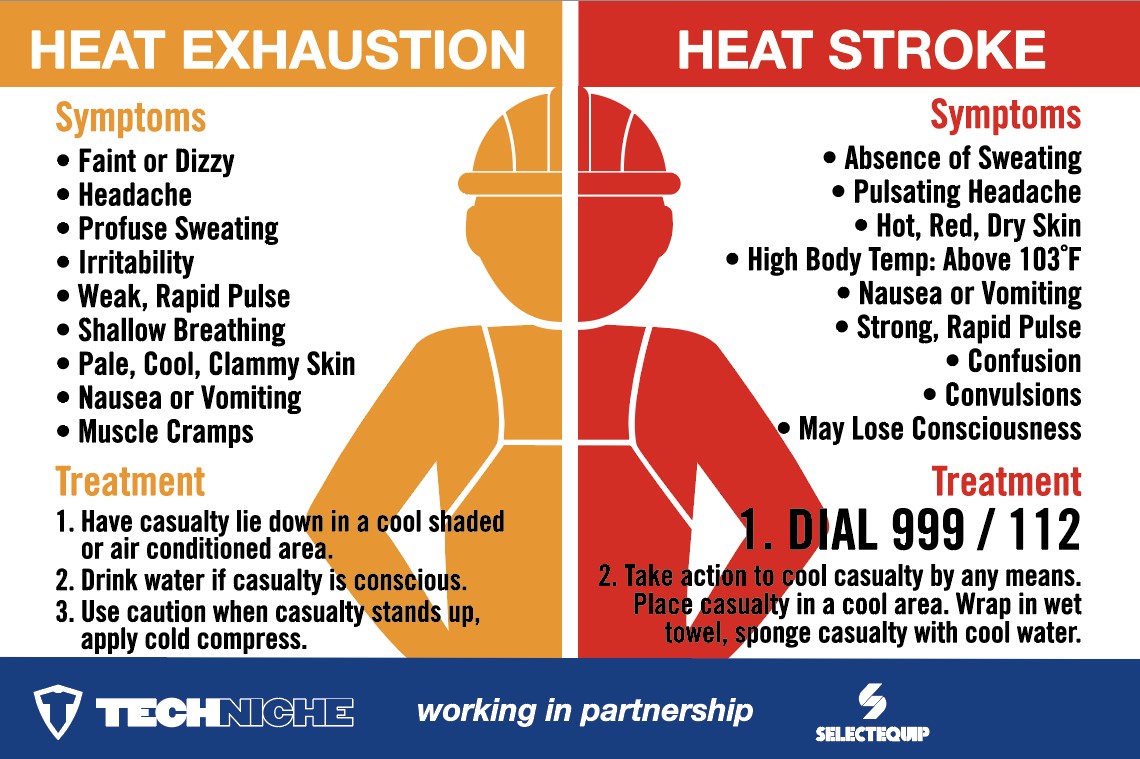Summer is here. But how prepared are you for the heat? This article looks at guidance provided by the Track Safety Alliance (TSA) about working in hot weather.
You might not think that ‘heat stress’ would be a major issue in the UK. After all, we are not known for our hot and sunny climate. But it is important to consider. When working in temperatures in the mid-20s degrees Celsius (°C) and beyond, the body can start to feel the effects, especially when wearing essential Personal Protective Equipment (PPE).

Heat stress info card. © TSA
What is heat stress?
Heat stress occurs when the body’s means of controlling its internal temperature starts to fail. As well as air temperature, factors such as work rate, humidity and clothing worn while working may lead to heat stress.
How does the body react to heat?
The body reacts to heat by increasing the blood flow to the skin’s surface, and by sweating. This results in cooling, as sweat evaporates from the body’s surface, and heat is carried to the surface of the body from within by the increased blood flow. Heat can also be lost by radiation and convection from the body’s surface.
Tips to avoid heat stress:
- Hydrate yourself! Remember to drink plenty of water (between 1.5 and two litres a day).
- Use sunscreen on exposed skin to protect it.
- Watch your workload. Be careful not to overdo it, as heat can lead to increased fatigue. If you can, share the load on site or in the office.
- Wear cooling workwear.
- Wear suitable hi-visibility clothing.
- Rest in the shade if possible.
- Monitor your sleep. It may be affected by the heat.
Hydration
Why?
Your body is nearly two-thirds water, so it is really important that you consume enough fluid to stay hydrated and healthy. It’s all too easy to forget this.
If you don’t get enough fluid, you may feel tired, get headaches and not perform at your best. Listen to your body’s needs.
How much?
This can depend on factors such as weather, physical exercise and your age. However, European recommendations suggest 1.6 litres of fluid per day for women, and two litres of fluid per day for men.
Choosing your drink
Be aware of what you are drinking. Although all drinks provide water and some also contain essential vitamins and minerals, they may also provide energy which will contribute to your daily calorie intake. Drinks such as energy drinks are not good for rehydrating your body. They may provide a short-term energy boost, but will not give you the amount of water your body needs in order to rehydrate.

Mild dehydration info card. © TSA
Shaded rest
The Met Office recorded the highest temperature in Britain in July 2019: 38.7°C in Cambridge, England. Find a spot in the shade when the temperature starts to creep up.
- Shaded rest is essential during peak summer. It is a responsibility of both employer and employee.
- Shaded rest allows for a workforce to rest, hydrate and cool down.
- Clothing to help with summer heat can be as simple as a cooling towel or cooling vest.
Heat stress reports made to CIRAS
CIRAS typically starts to take health and safety reports on the effects of heat from around May. Often the reports are about uncomfortable working conditions because of the heat. For example, a frequent topic has been the air conditioning on trains and buses, as well as in signalling and control centres.
Greenhouse effect
A train driver reported ineffective air conditioning systems that only blow out hot air. This left drivers feeling hot, bothered, and fatigued whilst driving. During the summer in the UK, with temperatures reaching almost 30°C, the large, glass windows on the units created a ‘greenhouse effect’ in the cab. Although the driving cabs had side windows, once opened it was difficult for the drivers to hear the safety systems inside the cab. This could have led to important safety information being lost.
10 hours in 40°C
A bus driver reported a lack of air conditioning in the drivers’ cabs. Buses were fitted with air conditioning units but this was not working sufficiently on older models. During the summer months, temperatures could exceed 40°C in the drivers’ cabs. This led to an unpleasant and uncomfortable working environment for drivers. They were spending up to 10 hours a day in the cab. This could impact the drivers' health and lead to a road traffic incident.
If you have similar concerns, do your best to raise them as early as possible before it becomes an issue!
Find out more
Tags
- Health and Wellbeing
- Person's Environment
